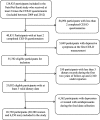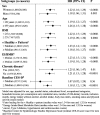Prospective association between ultra-processed food consumption and incident depressive symptoms in the French NutriNet-Santé cohort
- PMID: 30982472
- PMCID: PMC6463641
- DOI: 10.1186/s12916-019-1312-y
Prospective association between ultra-processed food consumption and incident depressive symptoms in the French NutriNet-Santé cohort
Abstract
Background: Ultra-processed food (UPF) consumption has increased over the last decades in Westernized countries. Our objective was to investigate for the first time the association between the proportion of UPF (%UPF) in the diet and incident depressive symptoms in the NutriNet-Santé cohort.
Methods: The sample included 20,380 women and 6350 men (aged 18-86 years) without depressive symptoms at the first Center for Epidemiologic Studies Depression Scale (CES-D) measurement, using validated cut-offs (CES-D score ≥ 17 for men and ≥ 23 for women). The proportion of UPF in the diet was computed for each subject using the NOVA classification applied to dietary intakes collected by repeated 24-h records (mean = 8; SD = 2.3). The association between UPF and depressive symptoms was evaluated using multivariable Cox proportional hazards models.
Results: Over a mean follow-up of 5.4 years, 2221 incident cases of depressive symptoms were identified. After accounting for a wide range of potential confounders, an increased risk of depressive symptoms was observed with an increased %UPF in the diet. In the main model adjusted for sociodemographic characteristics, body mass index, and lifestyle factors, the estimated hazard ratio for a 10% increase in UPF was 1.21 (95% confidence interval = 1.15-1.27). Considering %UPF in food groups, the association was significant only for beverages and sauces or added fats.
Conclusion: Overall, UPF consumption was positively associated with the risk of incident depressive symptoms, suggesting that accounting for this non-nutritional aspect of the diet could be important for mental health promotion.
Keywords: Depression; Mental health; Prospective cohort; Ultra-processed food.
Conflict of interest statement
Ethics approval and consent to participate
The NutriNet-Santé study is conducted in accordance with the Declaration of Helsinki and was approved by the ethics committee of the French Institute for Health and Medical Research (IRB Inserm no. 0000388FWA00005831) and by the National Commission on Informatics and Liberty (CNIL no. 908450 and no. 909216). Electronic informed consent was obtained from all participants.
Consent for publication
Not applicable.
Competing interests
Cédric Lemogne has received honoraria for board membership from Lundbeck and for speaking at invited symposia from Janssen, Lundbeck and Otsuka Pharmaceuticals.
The other authors declare that they have no conflict of interests.
Publisher’s Note
Springer Nature remains neutral with regard to jurisdictional claims in published maps and institutional affiliations.
Figures


References
-
- GBD 2016 Disease and Injury Incidence and Prevalence Collaborators Global, regional, and national incidence, prevalence, and years lived with disability for 328 diseases and injuries for 195 countries, 1990–2016: a systematic analysis for the Global Burden of Disease Study 2016. Lancet Lond Engl. 2017;390:1211–1259. doi: 10.1016/S0140-6736(17)32154-2. - DOI - PMC - PubMed
-
- WHO Fact sheet - Depression. World Health Organization. 2018. http://www.who.int/news-room/fact-sheets/detail/depression. Accessed 7 June 2018.
Publication types
MeSH terms
LinkOut - more resources
Full Text Sources
Other Literature Sources
Medical

